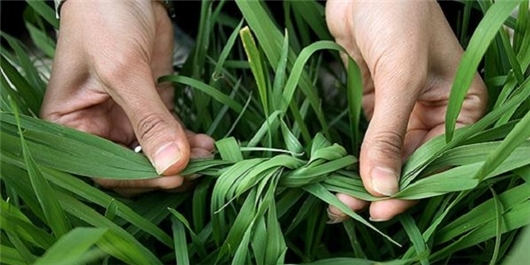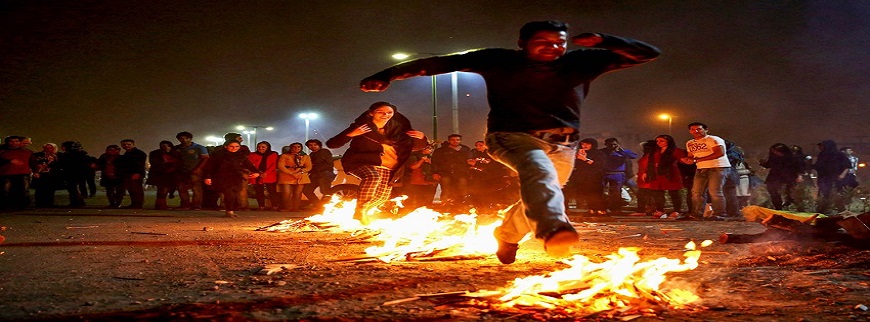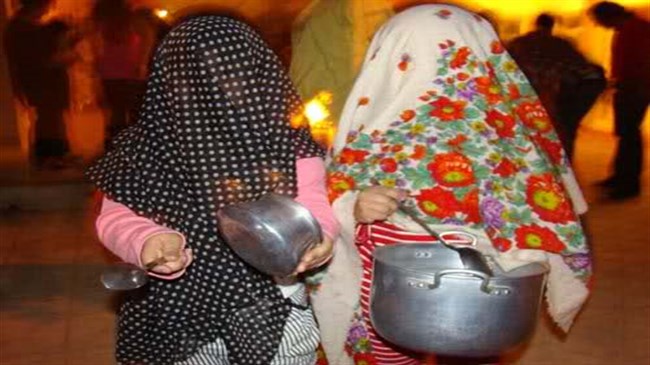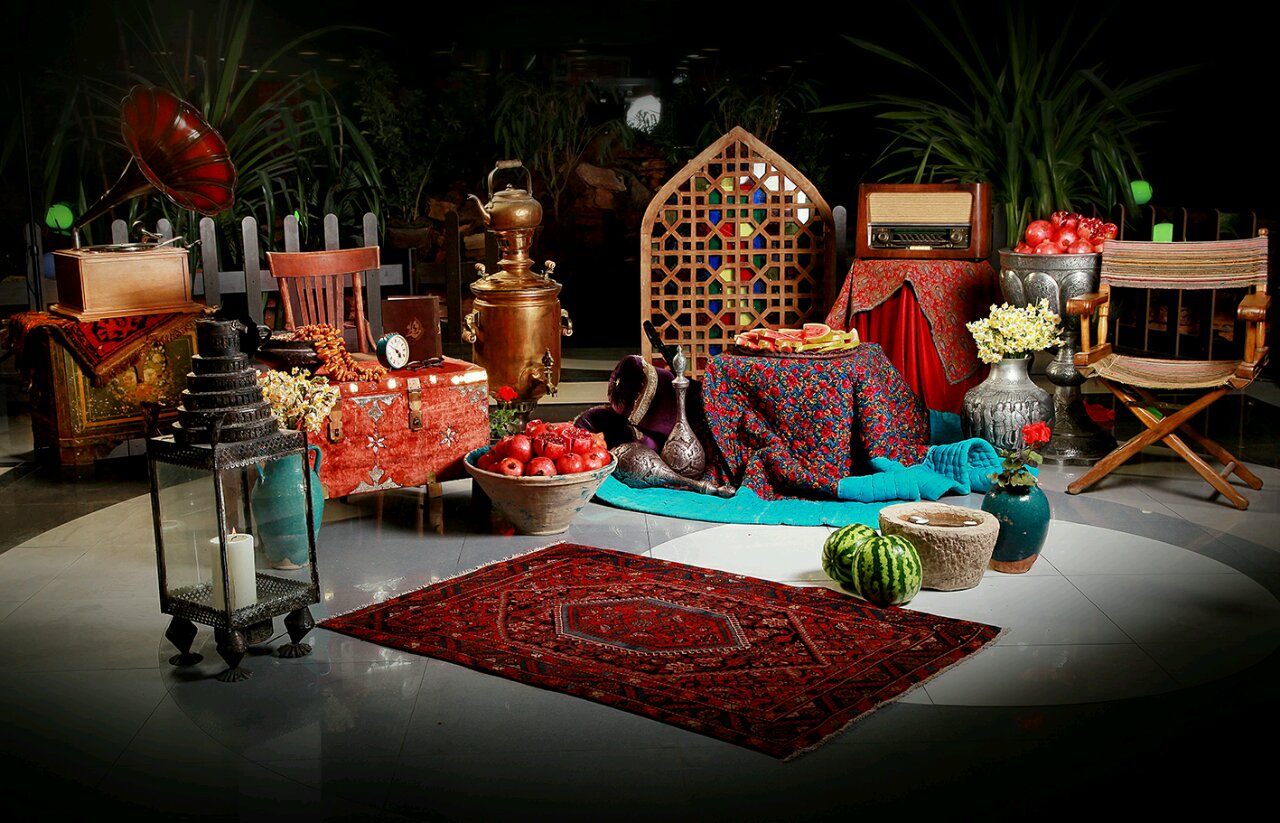Ancient Persian Festivals

Iranians created many feasts and celebrations to pay homage to many deities and they are mostly farming festivals.
Iranians divide the Iranian year into two equal parts or seasons. The first season was summer and the second was winter.The coming of the two seasons would be celebrated through Norooz and Mehregan. The later is the festival dedicated to Mehr Izad. It is celebrated on the 16th of the seventh month (Mehr) at the time of the harvest festivals and beginning of the winter. It has been the second most elaborate celebration after Norooz.
Norooz - New Year Festival
Norooz, in word, means "New Day". It is the new day that starts the year, traditionally the exact astronomical beginning of the Spring. Iranians take that as the beginning of the year. This exact second is called "Saal Tahvil". No-Rooz with its' uniquely Iranian characteristics has been celebrated for at least 3,000 years and is deeply rooted in the rituals and traditions of the Zoroastrian (This was the religion of ancient Persia before the advent of Islam in 7th century A.D.).
Iranians consider No-Rooz as their biggest celebration of the year, before the new year, they start cleaning their houses (Khaane Tekaani), and they buy new clothes. But a major part of New Year rituals is setting the "Haft Seen" with seven specific items. In ancient times each of the items corresponded to one of the seven creations and the seven holy immortals protecting them. Today they are changed and modified but some have kept their symbolism. All the seven items start with the letter "S"; this was not the order in ancient times. These seven things usually are: Seeb (apple), Sabze (green grass), Serke (vinager), Samanoo (a meal made out of wheat), Senjed (a special kind of berry), Sekke (coin), and Seer (garlic). Sometimes instead of Serke they put Somagh (sumak, an Iranian spice). Zoroastrians today do not have the seven "S"s but they have the ritual of growing seven seeds as a reminder that this is the seventh feast of creation, while their sprouting into new growth symbolized resurrection and eternal life to come.
Wheat or lentil representing new growth is grown in a flat dish a few days before the New Year and is called Sabzeh (green shoots). Decorated with colorful ribbons, it is kept until Sizdah beh dar, the 13th day of the New Year, and then disposed outdoors. A few live gold fish (the most easily obtainable animal) are placed in a fish bowl. In the old days they would be returned to the riverbanks, but today most people will keep them. Mirrors are placed on the spread with lit candles as a symbol of fire. Most of the people used to place Qoran on their Sofreh (spread) in order to bless the New Year. But some people found another alternative to Qoran and replaced it by the Divan-e Hafez (poetry book of Hefez), and during "Saal Tahvil" reading some verses from it was popular. Nowadays, a great number of Iranians are placing Shahnameh (the Epic of Kings) of Ferdowsi on their spread as an Iranian national book. They believe that Shahnameh has more Iranian identity values and spirits, and is much suitable for this ancient celebration.
After the Saal Tahvil, people hug and kiss each other and wish each other a happy new year. Then they give presents to each other (traditionally cash, coins or gold coins), usually older ones to the younger ones. The first few days are spent visiting older members of the family, relatives and friends. Children receive presents and sweets, special meals and "Aajil" (a combination of different nuts with raisins and other sweet stuff) or fruits are consumed. Traditionally on the night before the New Year, most Iranians will have Sabzi Polo Mahi, a special dish of rice cooked with fresh herbs and served with smoked and freshly fried fish. Koukou Sabzi, a mixture of fresh herbs with eggs fried or baked, is also served. The next day rice and noodles (Reshteh Polo) is served. Regional variations exist and very colorful feasts are prepared.
Sizdah Bedar
The 13th day of the new year is called "Sizdah Bedar" and spent mostly outdoors. People will leave their homes to go to the parks or local plains for a festive picnic. It is a must to spend Sizdah Bedar in nature. This is called Sizdah Bedar and is the most popular day of the holidays among children because they get to play a lot! Also in this day, people throw the Sabze away, they believe Sabze should not stay in the house after "Sizdah Bedar". Iranians regard 13th day as a bad omen and believe that by going into the fields and parks they avoid misfortunes. It is also believed that unwed girls can wish for a husband by going into the fields and tying a knot between green shoots, symbolizing a marital bond.

Chahrshanbe Souri - Festival of fire
"Give me your fiery red color/ take back my wintry shallowness yellow." It is an annual ritual which is held on the eve of the last Wednesday of the Iranian year.
Chahrshanbe Souri is the symbol of good health, cultivation, light, and purity to the Iranian. It is believed that the ritual guarantees the dissipation of the misfortunes and evils, and of course, the materialization of people's hopes and desires for the next year.
Before the dusk, seven, as a symbol for the seven Zoroastrian angels (Amshaaspandan), heaps of bushes (of weed) are gathered before the house-gate or on the roof of the house -some visible place for the "ghosts" to guide. After the night has fallen on, the heaps are kindled and the uproarious tumult begins.
It is time for everybody to leap over the bonfires. They dance and sing merry notes. The traditional song of the night is: "Sorkhi-e man az to/ Zardi-e to az man", literally it means "Give me your fiery red color and take back my wintry shallowness".

Qaashoq-Zani (Spoon-hitting)
Very much like Halloween and in full disguise, usually a veil (chador) covering the entire body, longing youths go to seven different houses and make a noise by hitting a bowl with a spoon to signal the household residing in the house. Being presented, by the household, with some treat betokens a positive omen, and vice versa.
Faal-e-Gusheneshini (solitary telling of the fortune) Young women longing for a spouse make a wish, then having hidden themselves in some invisible dark corner of a passage, listen to the passers-by's talks, according to which they decide whether their wish will or will not be fulfilled; passers-by's positive talk signifies good omens, and unpleasant words point to some ill portent.

Kuze-Shekani (earthenware jar-shattering)
The household put some coal, as the sign of ill omen, and some salt, standing for evil eye, plus a cheap coin, signifying poverty, inside an earthenware jar. They turn the earthenware jar around their heads one by one. Then, one of them throws the jar over the roof onto the alley. Thus, ill omen, evil eye and poverty are driven out of the house.
Shaal-Andazi (shawl-dropping)
In some parts of the country, young boys, who are engaged, drop a shawl or wraparound down from the roof of their fiance's house and she would present him with some confection or other present. Along with these rites, there are also others such as making soup for the sick, discarding the outworn furniture, etc. In some areas, the young get their horses out and make a performance on it before the night falls on.
Mehregan - Fall Festival
This feast would be celebrated for 6 days, starting on the 16th day of Month Mehr The oldest historical record about Mehregan goes back to the Achaemenian times. The Historian, Strabon (66 - 24 BC) has mentioned that the Armenian Satrap (governor) presented the Achaemenian king with 20,000 horses at the Mehregan celebrations.
The festival prayers are performed by the Mobads (priests) and gifts such as pure oil for the sanctuary lamps, candles and incense are presented to the local shrines. Esphand a local popular incense is burnt and sweet smelling flowers and herbs are dedicated to the temples. Contrary to the ancient times, there is no rigidly prescribed pattern of behavior for approaching the shrines, but many still touch the doorsill before entering in a graceful gesture of obeisance, while uttering prayers and invocations. Iranian Muslims still follow the same procedure once approaching a mosque.
For the ancient Iranians Mehr symbolized truthfulness, bravery and courage. These attributes were re-enforced and venerated through prayers, rituals, feasts, celebrations and acts of charity. Though most modern Iranians have heard about Mehregan, but unlike Norooz it is not celebrated by all and is mainly regarded as a Zoroastrian festival. In the recent years there has been a revival of this joyful and merry occasion both in Iran and outside and more Iranians are participating in this festival. Also since, school year starts on 1st of the Persian month Mehr, on about 23 September, in Iran, Mehregan is celebrated as a time to rejoice learning and knowledge to make the festival more acceptable with the Islamic authorities.
Sadeh - Winter Festival

Sadeh meaning hundred is a mid winter festival in Iran. It is a festivity to honor fire and to defeat the forces of darkness, frost and cold. It is celebration marked the hundred day and nights (50 days and 50 nights) before the Norooz and the hundredth day after the summer. This day coincides with 10th of Bahman in present calendar.
The ceremony starts with huge bon fires. People would dance around the fires. The most elaborate report of the celebration comes from the 10th century during the reign of Mardavij Zeyari, the ruler of Isfahan. From Iranian origin the Zeyari family did their best to keep the old traditions alive. Huge bon fires were set up on both sides of the Zayandeh Roodâ, the main river dividing the city. The fires were contained in specially build metal holders to maintain control. Hundreds of birds were released while carrying little fireballs to light the sky. There were fireworks, clowns, dance and music with lavish feasts of roasted lamb, beef, chicken and other delicacies.
The wood gathered would be taken to the local shrine and on their return home if it is their first time there will be a celebration for the boys at home with friends and relatives. However this practice is becoming more difficult these days and attempts are made to preserve it. The work is hard, wood more scarce than ever, fewer boys are prepared to attempt it and safety is a major concern. In addition massive emigration into the cities or outside the country has significantly reduced the number of boys available for this occasion.
The fire is kept burning all night. The day after, first thing in the morning, women would go to the fire and each one will carry a small portion back to their homes and new glowing fires are made from the ritually blessed fire. This is to spread the blessing of the Sadeh fire to every household in the neighborhood. Whatever that is left of the fire will be taken back to the shrine to be pilled in one container and will be kept at the temple. The festivities would normally go on for three days and the wood gathering by the boys door to door and blessing of the dead happens every night and evenings are spend eating and giving away khairat(giving away as a good deed). Food prepared from slaughtered lamb and ash e khairat are distributed amongst the less fortunate.
Today, Sadeh is mainly celebrated on 10th of Bahman. The fires may or may not be lit outside and most activities take place inside the shrines. The wood gathering activities are reduced though there are efforts to preserve them. However the bulk of the Iranians are becoming more familiar with the occasion and there are gatherings and celebrations outside Iran. Fires are lit, music, dancing and merriment of all kinds will go on for the rest of the evening. The occasion for the majority of Iranians has no religious significance and no specific rituals are involved other than torching bon fires at sunset and having a merry time and therefore keeping up with the ancient traditions when merriment was venerated and practiced.
Yalda Festival or Shab e Cheleh - The Night of the Fortieth

Yalda, a Syric word imported into the Persian language by the Syriac Christians means birth (tavalud and melaad are from the same origin). It is a relatively recent arrival and it is refereed to the ‘Shab e Cheleh Festival’, a celebration of Winter Solstice on December 21st. Forty days before the next major Persian festival ‘Jashn e Sadeh’; this night has been celebrated in countless cultures for thousands of years. The ancient Roman festivals of Saturnalia (God of Agriculture, Saturn) and Sol Invicta (Sun God) are amongst the best known in the Western world.
In most ancient cultures, including Persia, the start of the solar year has been marked to celebrate the victory of light over darkness and the renewal of the Sun. For instance, Egyptians, four thousand years ago celebrated the rebirth of the sun at this time of the year. They set the length of the festival at 12 days, to reflect the 12 divisions in their sun calendar. They decorated with greenery, using palms with 12 shoots as a symbol of the completed year, since a palm was thought to put forth a shoot each month.
The Persians adopted their annual renewal festival from the Babylonians and incorporated it into the rituals of their own Zoroastrian religion. The last day of the Persian month Azar is the longest night of the year, when the forces of Ahriman are assumed to be at the peak of their strength. While the next day, the first day of the month ‘Day’ known as ‘khoram rooz’ or ‘khore rooz’ (the day of sun) belongs to Ahura Mazda, the Lord of Wisdom. Since the days are getting longer and the nights shorter, this day marks the victory of Sun over the darkness. The occasion was celebrated in the festival of ‘Daygan’ dedicated to Ahura Mazda, on the first day of the month ‘Day’.
Fires would be burnt all night to ensure the defeat of the forces of Ahriman. There would be feasts, acts of charity and a number of deities were honored and prayers performed to ensure the total victory of sun that was essential for the protection of winter crops. There would be prayers to Mithra (Mehr) and feasts in his honor, since Mithra is the Eyzad responsible for protecting ‘the light of the early morning’, known as ‘Havangah’. It was also assumed that Ahura Mazda would grant people’s wishes, specially those with no offspring had the hope to be blessed with children if performed all rites on this occasion.
One of the themes of the festival was the temporary subversion of order. Masters and servants reversed roles. The king dressed in white would change place with ordinary people. A mock king was crowned and masquerades spilled
into the streets. As the old year died, rules of ordinary living were relaxed. This tradition persisted till Sassanian period, and is mentioned by Biruni and others in their recordings of pre-Islamic rituals and festivals. Its’ origin goes back to the Babylonian New Year celebration. These people believed the first creation was order that came out of chaos. To appreciate and celebrate the first creation they had a festival and all roles were reversed. Disorder and chaos ruled for a day and eventually order was restored and succeeded at the end of the festival.
The Egyptian and Persian traditions merged in ancient Rome, in a festival to the ancient god of seedtime, Saturn. The Romans exchanged gifts, partied and decorated their homes with greenery. Following the Persian tradition, the
usual order of the year was suspended. Grudges and quarrels forgotten, wars would be interrupted or postponed. Businesses, courts and schools were closed. Rich and poor became equal, masters served slaves, and children headed the family. Cross-dressing and masquerades, merriment of all kinds prevailed. A mock king, the Lord of Misrule, was crowned. Candles and lamps chased away the spirits of darkness.
Another related Roman festival celebrated at the same time was dedicated to Sol Invictus (“the invincible sun”). Originally a Syrian deity, this cult was imported by Emperor Heliogabalus into Rome and Sol was made god of the
state. With the spread of Christianity, Christmas celebration became the most important Christian festival. In the third century various dates, from December to April, were celebrated by Christians as Christmas. January 6 was the most favored day because it was thought to be Jesus’ Baptismal day (in the Greek Orthodox Church this continues to be the day to celebrate Christmas). In year 350, December 25 was adopted in Rome and gradually almost the entire Christian Church agreed to that date, which coincided, with Winter Solstice and the festivals, Sol Invicta and Saturnalia. Many of the rituals and traditions of the pagan festivals were incorporated into the Christmas celebration and are still observed today.
It is not clear when and how the world ‘Yalda’ entered the Persian language. The massive persecution of the early Christians in Rome brought many Christian refugees into the Sassanin Empire and it is very likely that these Christians introduced and popularized ‘Yalda’ in Iran. Gradually ‘Shab e Yalda’ and ‘Shab e Cheleh’ became synonymous and the two are used interchangeably.
With the conquest of Islam the religious significance of the ancient Persian festivals was lost. Today ‘Shab e Cheleh’ is merely a social occasion, when family and friends get together for fun and merriment. Different kinds of dried fruits, nuts, seeds and fresh winter fruits are consumed. The presence of dried and fresh fruits is reminiscence of the ancient feasts to celebrate and pray to the deities to ensure the protection of the winter crops.